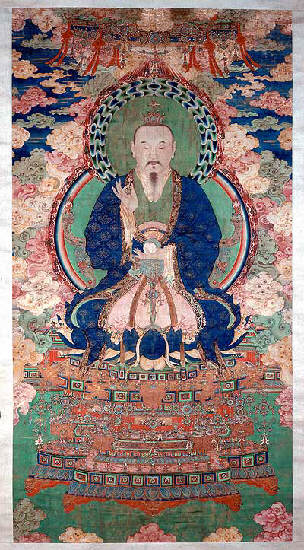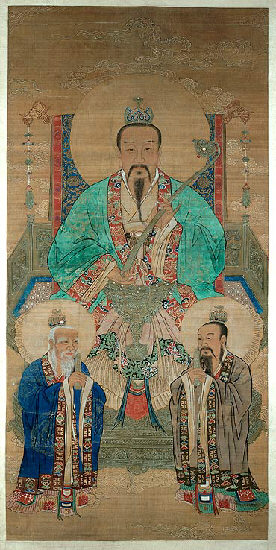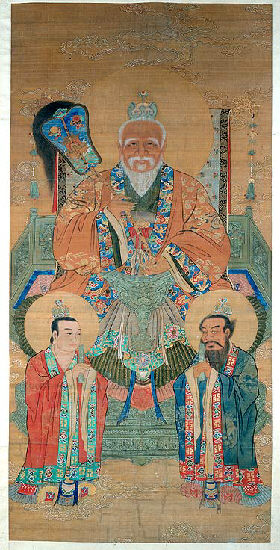| This is the central deity of the Three Purities, the Celestial
Worthy of Primordial Beginning (Tianzun Yuanshi 天尊元始). As his name implies,
he is believed to have spontaneously formed from pure energy at the beginning
of the world. According to legend, he observed the shifting patterns of
energy and created the first writing system from them by casting the patterns
in gold onto jade tablets. Consequently, he is seen as both the source of
all learning and the first author of Daoist scriptures. The first and loftiest
section of the Daoist Canon is dedicated to him. Here, he is shown seated
on an elaborate throne that hovers in the cloudlike energy of his celestial
realm. He is dressed in the manner of a Daoist priest, with his hands in
a magical gesture that imitates a Buddhist mudra. His spiritual energy
radiates outward in a mandorla of swirling colors.
|
This painting shows the second of the Three Purities, the
Celestial Worthy of Numinous Treasure (Tianzun Lingbao 天尊靈寶). His name comes
from the scriptures written in response to the growing influence of Buddhism
in the early fifth century. These writings eventually formed the basis for
the second section of theDaoist Canon, which is dedicated to the Celestial
Worthy of Numinous Treasure. Like the Celestial Worthy of Primordial Beginning,
he is considered a source of Daoist knowledge and scripture. He is often
described as the attendant of the Celestial Worthy of Primordial Beginning,
who gives him the task of revealing the scriptures to lesser gods and humans.
As such, he is the principal disseminator of Taoist teachings. He is depicted
here sitting on a throne in his celestial realm and holding his identifying
attribute, a scepter in the shape of a mushroom called a ruyi. The
hierarchic scale of his two attendants emphasizes the superiority of this
lofty god.
|
This is the Celestial Worthy of the Way and Its Power (Tianzun
Daode 天尊道德), or Laozi. The god's
identity is indicated by the presence of his defining attribute, a fan with
fly-whisk. His divine title was derived from the name of the text attributed
to him: the Classic of the Way and Its Power (Daode jing). Since
the name Laozi literally means "elder master," he is shown with white hair
and an aged face, unlike the other two Celestial Worthies. Laozi also differs
from the others in that he played an active role in the development of Chinese
civilization, often appearing to reveal divine teachings to humanity.
Here, he sits on a throne in his celestial kingdom, attended by two figures
whose lesser stature serves to emphasize his magnificence. The figure on
the right is Zhang Daoling, the first Celestial Master and the founder of
the Way of the Celestial Masters, which formed the foundation for religious
Daoism. Zhang accompanies Laozi because he was supposedly inspired by a
vision of the sage master. The other figure may represent Yin Xi, the man
to whom Laozi first revealed the Classic of the Way and Its Power. The artist's
choice of these two attendants as the most important representatives of
Laozi on earth highlights Laozi's active participation in the human realm.
|


